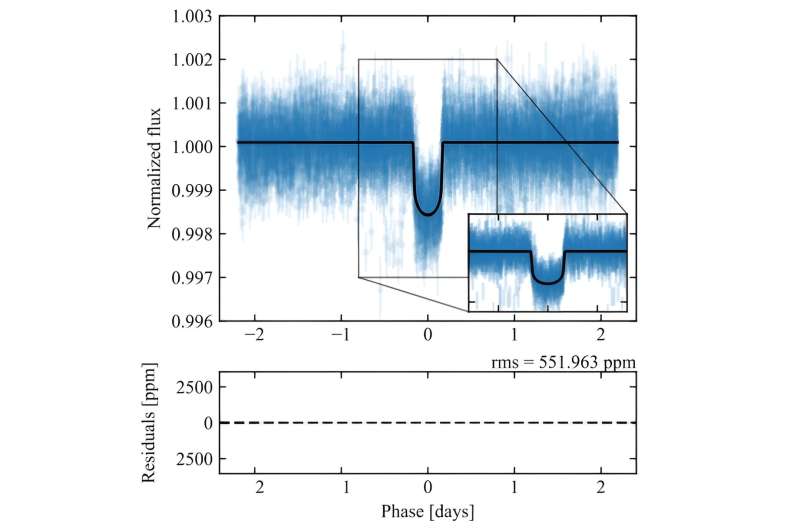November 23, 2023 report
This article has been reviewed according to Science X's editorial process and policies. Editors have highlighted the following attributes while ensuring the content's credibility:
fact-checked
peer-reviewed publication
trusted source
proofread
Astronomers discover two 'hot Jupiters' orbiting red-giant stars

Using NASA's Transiting Exoplanet Survey Satellite (TESS), an international team of astronomers has discovered two new "hot Jupiter" exoplanets. The newfound alien worlds, designated TOI-4377 b and TOI-4551 b, both orbit distant red-giant stars. The finding was reported November 8 in the Monthly Notices of the Royal Astronomical Society.
Launched in April 2018, TESS is conducting a survey of about 200,000 of the brightest stars near the sun with the aim of searching for transiting exoplanets, ranging from small, rocky worlds to gaseous giants. To date, it has identified nearly 7,000 candidate exoplanets (TESS Objects of Interest, or TOI), of which 402 have been confirmed so far.
A group of astronomers led by Filipe Pereira of the University of Porto, Portugal, has now confirmed another two TOIs monitored by TESS. They identified a transit signal in the light curve of red-giant stars known as TOI-4377 and TOI-4551, located 1,486 and 704 light years away. The planetary nature of these signals was verified by follow-up radial velocity observations using ground-based telescopes.
"The planets were found during a search for transits around bright, low-luminosity red-giant branch stars observed by TESS in the southern ecliptic hemisphere," the researchers wrote in the paper.
TOI-4377 b has a radius of about 1.35 Jupiter radii and has a mass of some 0.96 Jupiter masses, which yields a density at a level of 0.88 g/cm3. The planet orbits its host every 4.38 days, at a distance of 0.058 AU, and its equilibrium temperature.
When it comes to TOI-4551 b, its radius is about 6% larger than that of Jupiter, while its mass is estimated to be 1.49 Jupiter masses. Therefore, the planet's density was calculated to be 1.74 g/cm3. The observations show that TOI-4551 b has an orbital period of approximately 10 days and is separated from its parent star by 0.1 AU.
The stars TOI-4377 and TOI-4551 have masses of 1.36 and 1.31 solar masses, respectively. They are both about 3.5 times larger than the sun and have effective temperatures of almost 5,000 K. TOI-4377 is estimated to be 3.88 billion years old, while TOI-4551 is about 1 billion years older.
Summing up the results, the authors of the paper concluded that TOI-4377 b and TOI-4551 b can be both classified as "hot Jupiters" and are a rare example of giant alien worlds with short orbital periods, orbiting red giants. The so-called hot Jupiters are similar in characteristics to the solar system's biggest planet, with orbital periods of less than 10 days. Such exoplanets have high surface temperatures, as they orbit their parent stars very closely.
"All in all, the two newly confirmed planets enrich the existing population of known hot Jupiters orbiting evolved hosts. They should prove particularly relevant to demographic studies of short-period giant planets around red-giant stars, where only a handful of planets are known," the researchers explained.
More information: Filipe Pereira et al, TESS giants transiting giants V—Two hot Jupiters orbiting red-giant hosts, Monthly Notices of the Royal Astronomical Society (2023). DOI: 10.1093/mnras/stad3449. On arXiv: DOI: 10.48550/arxiv.2311.06678
Journal information: arXiv , Monthly Notices of the Royal Astronomical Society
© 2023 Science X Network




















